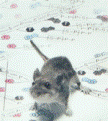Papers in the Biological Sciences

Jay F. Storz Publications
Document Type
Article
Date of this Version
April 2008
Abstract
In hybrid zones between genetically differentiated populations, variation in locus-specific rates of introgression may reflect adaptation to different environments or adaptation to different genetic backgrounds. The European rabbit, Oryctolagus cuniculus, is well-suited to studies of such hybrid zone dynamics because it is composed of two genetically divergent subspecies that hybridize in a zone of secondary contact in central Iberia. A species-wide survey of allozyme variation revealed a broad range of locus-specific divergence levels (FST ranged from 0 to 0.54, mean FST = 0.16). Interestingly, the two loci that fell at opposite ends of the distribution of FST values, hemoglobin α-chain (HBA) and hemoglobin β-chain (HBB), encode interacting subunits of the hemoglobin protein. The contrasting patterns of spatial variation at these two loci could not be reconciled under a neutral model of population structure. The HBA gene exhibited higher-thanexpected levels of population differentiation, consistent with a history of spatially varying selection. The HBB gene exhibited lower-thanexpected levels of population differentiation, consistent with some form of spatially uniform selection. Patterns of linkage disequilibrium and allele frequency variation do not appear to fit any simple model of two-locus epistatic selection.


Comments
Published in Heredity 100 (2008), pp. 602–609; doi: 10.1038/hdy.2008.26 Copyright © 2008 Nature Publishing Group. http://www.nature.com/hdy/ Used by permission.